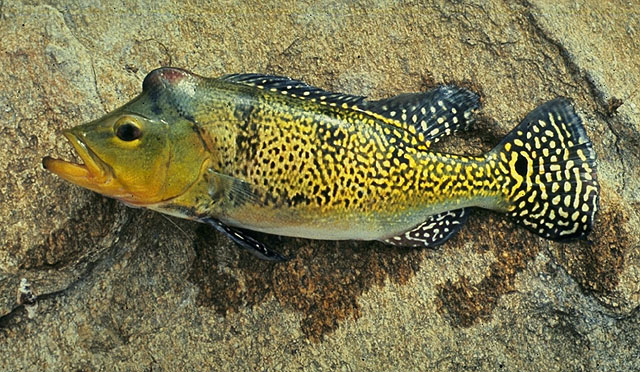Lot's of Kelberis around Hong Kong LFS's these days. Always like that, nothing then a flood. And they tend to come in lots, all juvis which seems to suggest they're bred. New to cichla and have searched around for an answer with out success.
As I understand it, a "Kelberi" is set apart by the spangling in the pelvic and anal fins. I thought there was only one kind and the stark differences were still variations of the same fish.
Conversation at a LFS with owner claimed there are 5 kinds. 2 from Brazil, 2 from Argentina, and 1 from Malaysia. The word for kelberi in cantonese is "brazilian gold tiger" and thus he said there are only 2 Kelberi Pbass truelly from brazil. These are more rare than the other "kelberi" because access is limited.
He went on to describe the various color types but I couldn't quite catch all that he said. I do remember him saying the true brazilian kelberi's have darker fin color for pelvic fins and white bellies (as opposed to red base color on fins, white bellies instead of yellow/green...
From the photos of kelberi fish found on internet and magazines, i noticed the following major differences. kelberis that a) look like monos with no body speckles, rather typical mono markings with speckles present only in pec/anal fins, b) those that look like (a) but have body speckles running on the upper back only, c) those that are yellow/gold from head to tail with severe full body speckles to the point verticle bars hardly visible d) same as (c) but body base color is darker and d) variations on speckled fins, some are jet black including tail while others are red, or so speckled that speckles run together making most the tail gold and e) red eyes, clear eyes.
Recently aquired kelberis from 2 different sources. apparently some are argentinian and others are brazilian. any more info or links experts can share are most appreciated. thanks!
here's examples of what i mean described above re. different color schemes on kelberi




As I understand it, a "Kelberi" is set apart by the spangling in the pelvic and anal fins. I thought there was only one kind and the stark differences were still variations of the same fish.
Conversation at a LFS with owner claimed there are 5 kinds. 2 from Brazil, 2 from Argentina, and 1 from Malaysia. The word for kelberi in cantonese is "brazilian gold tiger" and thus he said there are only 2 Kelberi Pbass truelly from brazil. These are more rare than the other "kelberi" because access is limited.
He went on to describe the various color types but I couldn't quite catch all that he said. I do remember him saying the true brazilian kelberi's have darker fin color for pelvic fins and white bellies (as opposed to red base color on fins, white bellies instead of yellow/green...
From the photos of kelberi fish found on internet and magazines, i noticed the following major differences. kelberis that a) look like monos with no body speckles, rather typical mono markings with speckles present only in pec/anal fins, b) those that look like (a) but have body speckles running on the upper back only, c) those that are yellow/gold from head to tail with severe full body speckles to the point verticle bars hardly visible d) same as (c) but body base color is darker and d) variations on speckled fins, some are jet black including tail while others are red, or so speckled that speckles run together making most the tail gold and e) red eyes, clear eyes.
Recently aquired kelberis from 2 different sources. apparently some are argentinian and others are brazilian. any more info or links experts can share are most appreciated. thanks!
here's examples of what i mean described above re. different color schemes on kelberi






